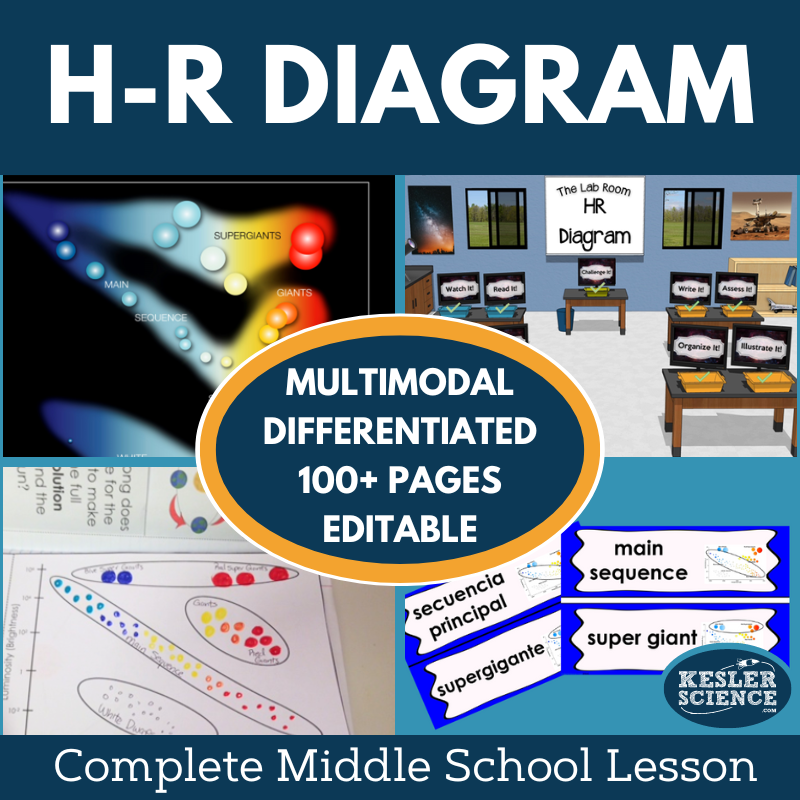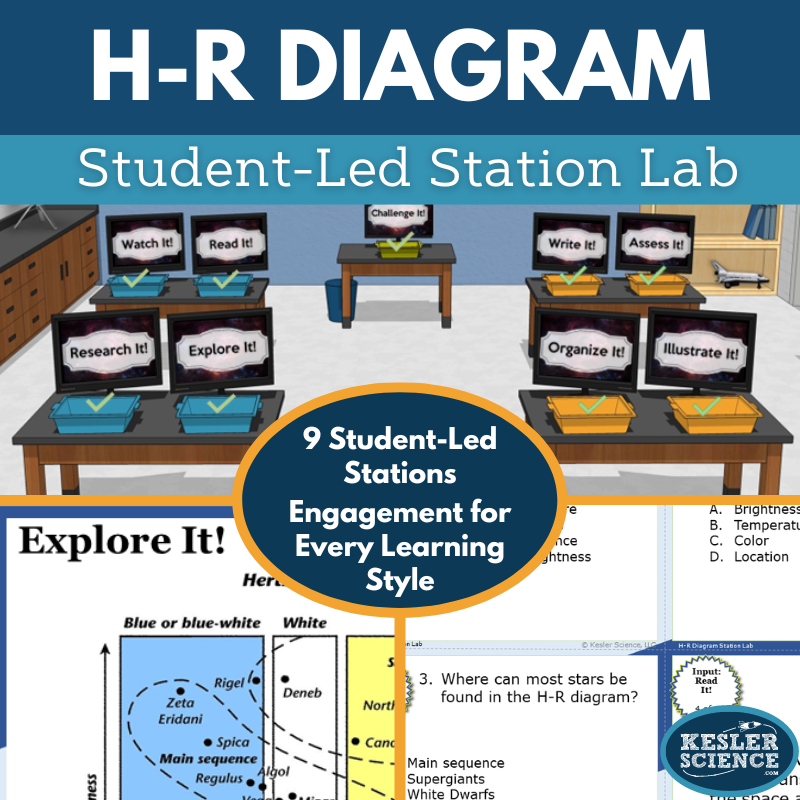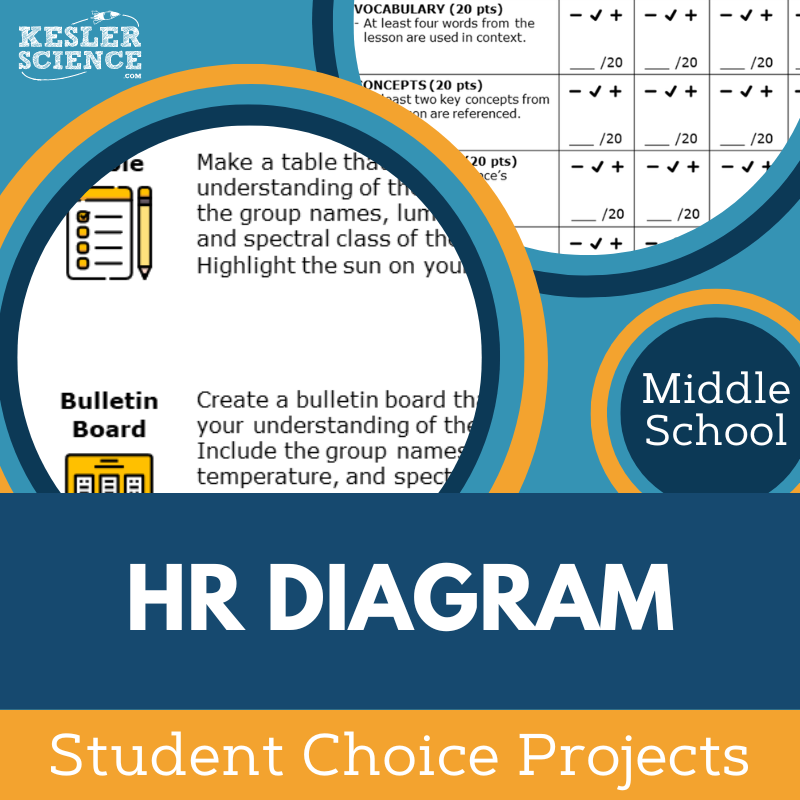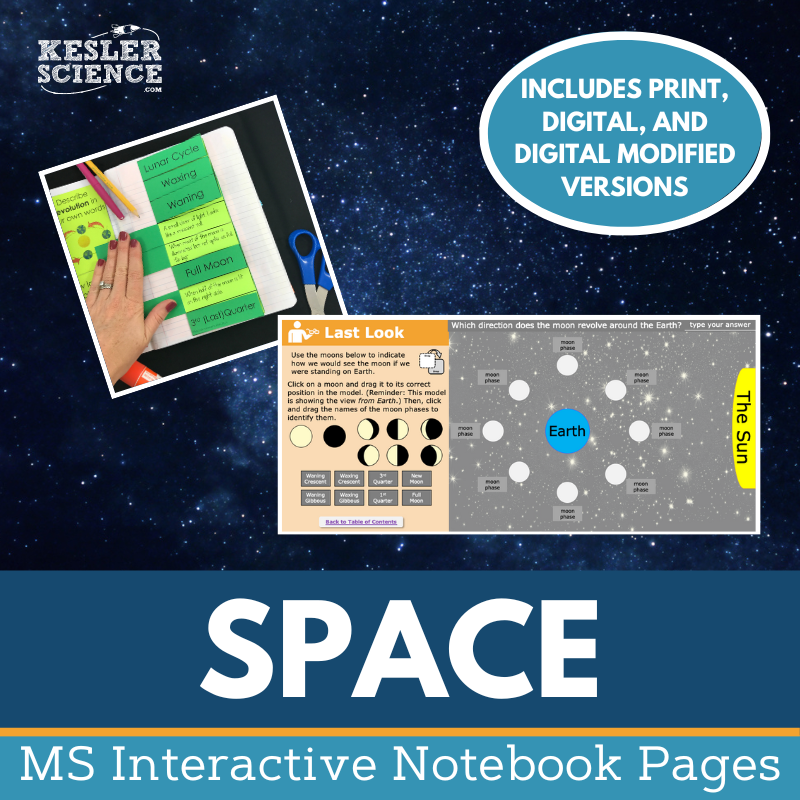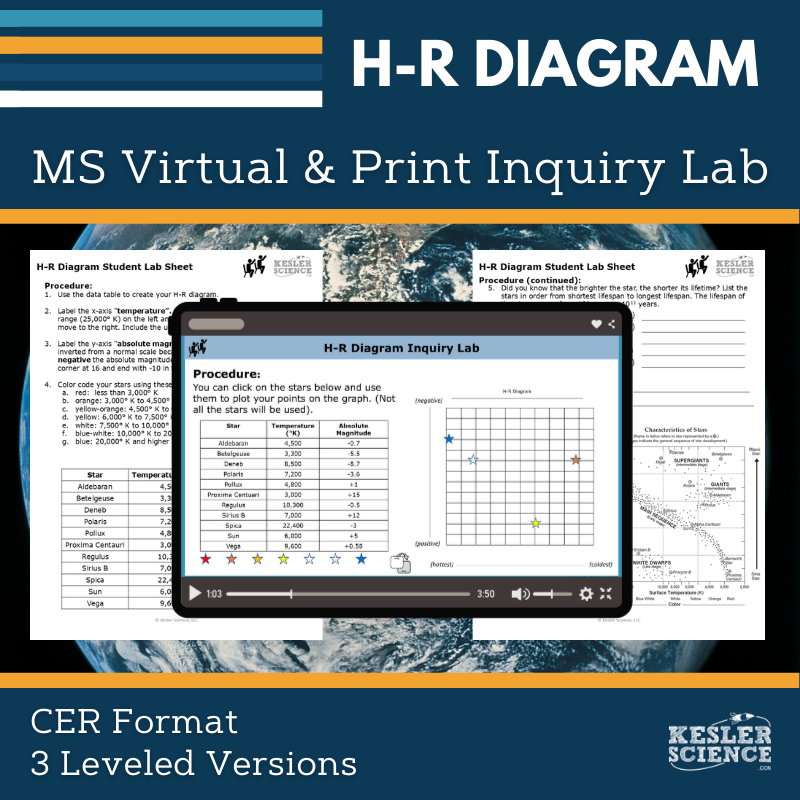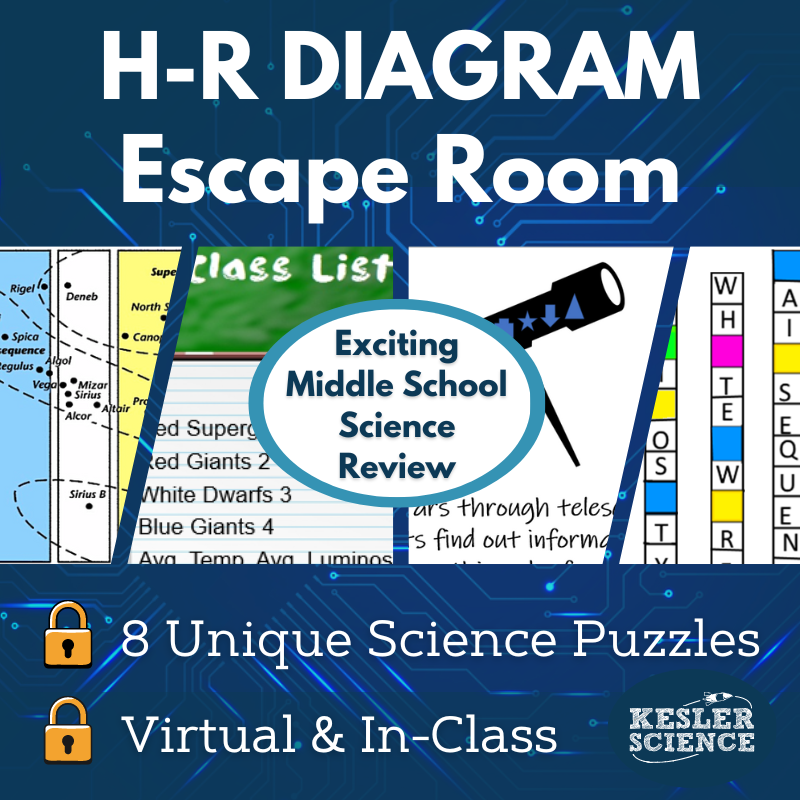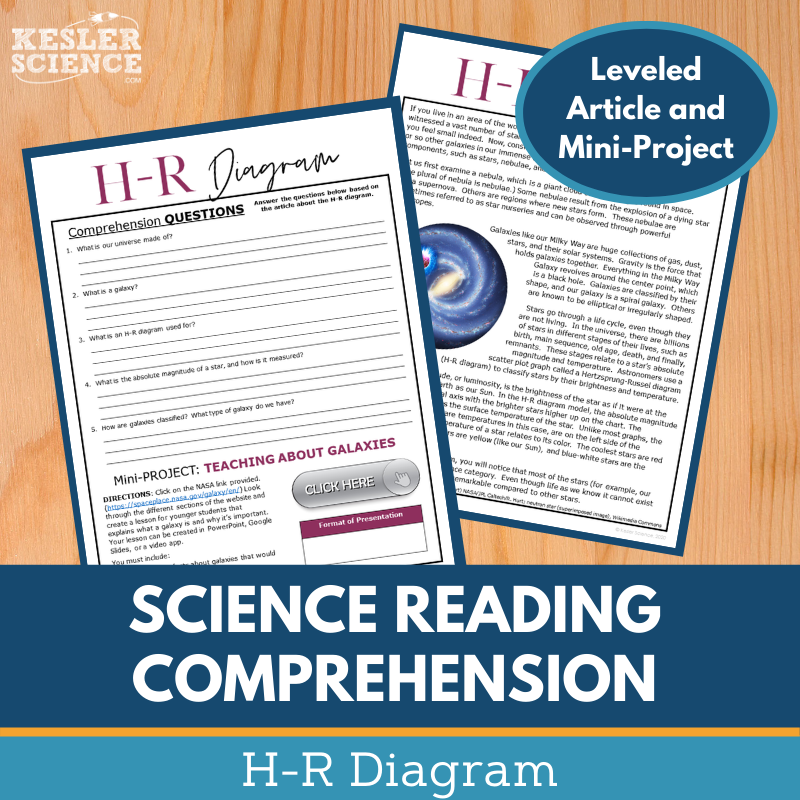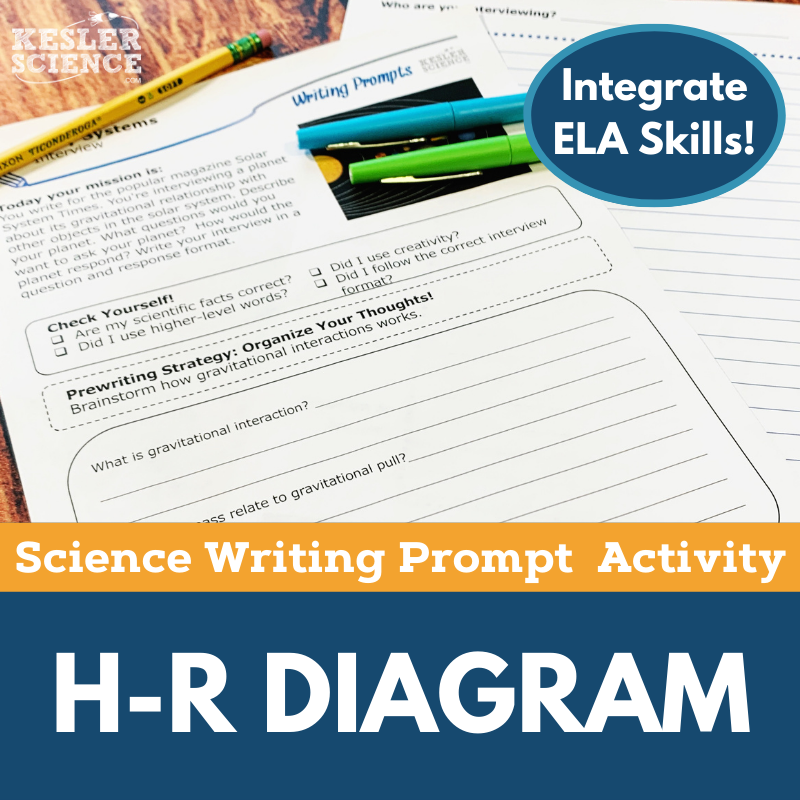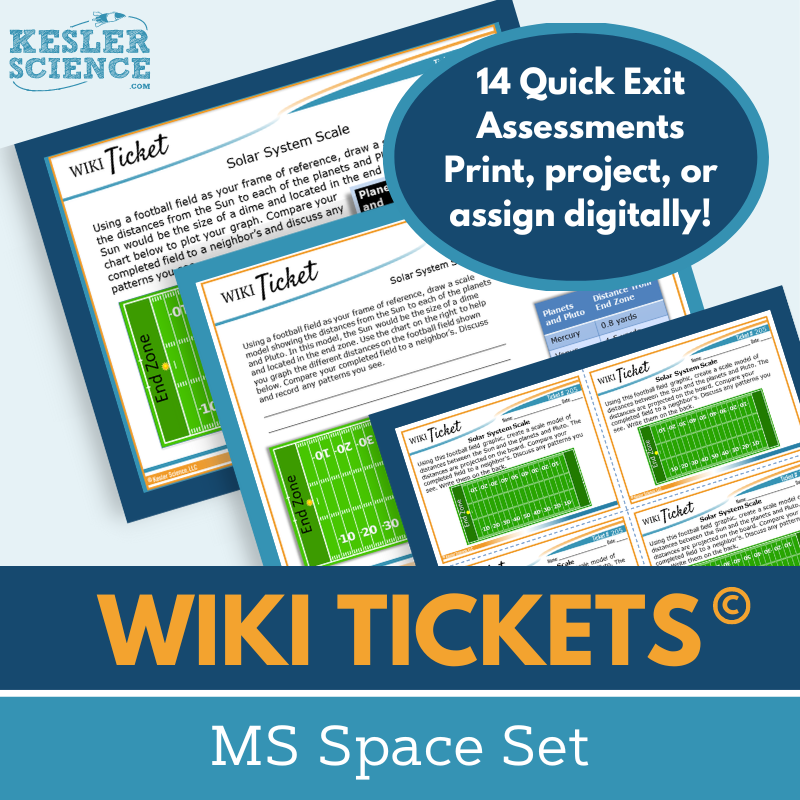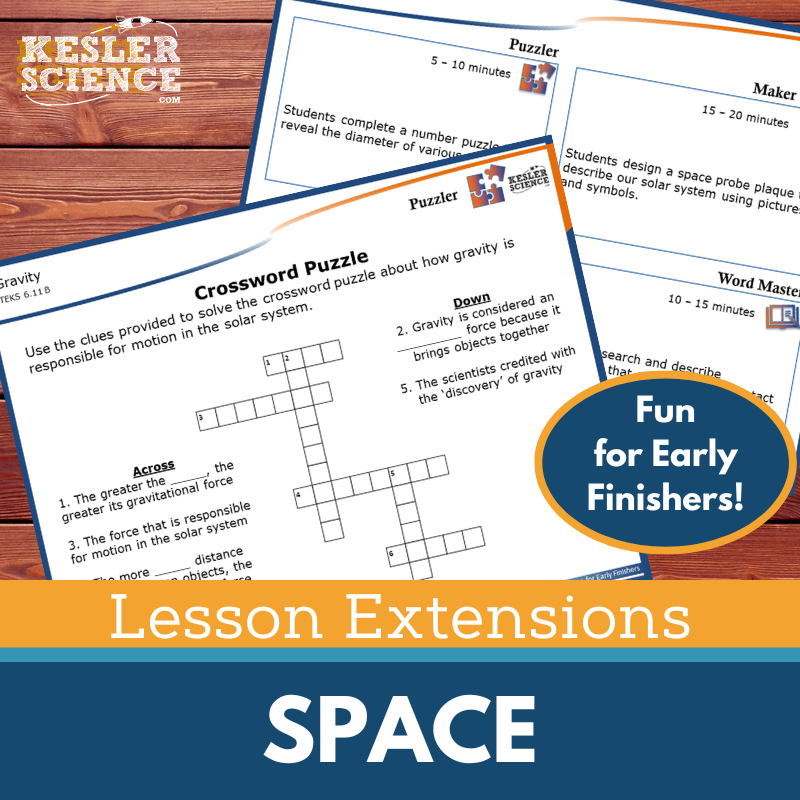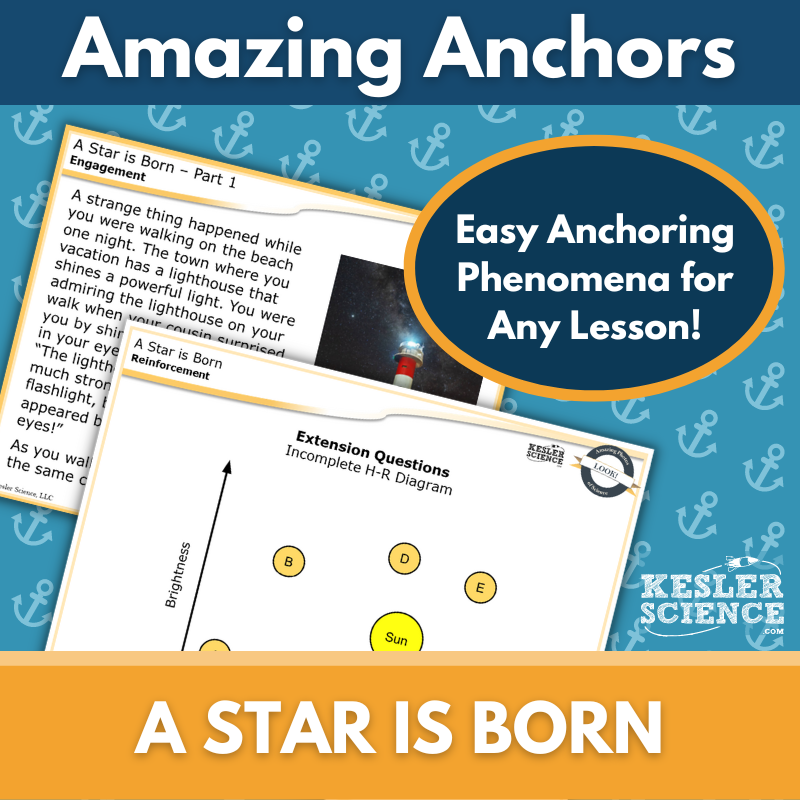H-R Diagram Activities for Middle School Science
The Kesler Science H-R Diagram resources provide a comprehensive, student-led learning experience for middle school students to explore star classification through the Hertzsprung-Russell Diagram. The resources below will give students a comprehensive understanding of H-R Diagrams. All of the following materials are also included in the Kesler Science Membership.
The Kesler Science H-R Diagram Complete Lesson provides a comprehensive, student-centered unit on star classification using the H-R Diagram, designed for middle school learners. This low-prep resource includes presentations, worksheets, assessments, and choice projects, with differentiated materials to support all students. The lesson follows the 5E Model—Engagement, Exploration, Explanation, Elaboration, and Evaluation—to guide students through the content while allowing teachers to focus on facilitating student success.
Students will explore the H-R Diagram through nine differentiated stations, covering input activities like "Explore It!", "Read It!", and "Watch It!", along with output activities such as "Organize It!", "Write It!", and "Illustrate It!". These stations cater to various learning styles and ensure students can engage with the material through hands-on, visual, and written methods. A bonus challenge station offers additional activities for advanced learners or early finishers.
This resource is perfect for both in-person and virtual learning environments, offering editable PowerPoints, interactive notebook templates, and assessments in both English and Spanish. Whether using print or digital formats, students can fully engage with the content and extend their learning with student-choice projects, helping them master key concepts about the H-R Diagram and the classification of stars.
The Kesler Science H-R Diagram Complete Lesson provides a comprehensive, student-centered unit on star classification using the H-R Diagram, designed for middle school learners. This low-prep resource includes presentations, worksheets, assessments, and choice projects, with differentiated materials to support all students. The lesson follows the 5E Model—Engagement, Exploration, Explanation, Elaboration, and Evaluation—to guide students through the content while allowing teachers to focus on facilitating student success.
Students will explore the H-R Diagram through nine differentiated stations, covering input activities like "Explore It!", "Read It!", and "Watch It!", along with output activities such as "Organize It!", "Write It!", and "Illustrate It!". These stations cater to various learning styles and ensure students can engage with the material through hands-on, visual, and written methods. A bonus challenge station offers additional activities for advanced learners or early finishers.
This resource is perfect for both in-person and virtual learning environments, offering editable PowerPoints, interactive notebook templates, and assessments in both English and Spanish. Whether using print or digital formats, students can fully engage with the content and extend their learning with student-choice projects, helping them master key concepts about the H-R Diagram and the classification of stars.
The Kesler Science H-R Diagram Station Lab is a modular, student-led activity designed to immerse middle school students in the study of the Hertzsprung-Russell Diagram and stellar classification. This low-prep resource encourages students to explore key concepts independently, using inquiry-based tasks that foster a deeper understanding of star types and their properties.
The station lab offers eight differentiated activities, with an additional challenge station for advanced learners, ensuring a personalized learning experience for all students. Input stations like "Explore It!", "Research It!", "Read It!", and "Watch It!" provide diverse ways to introduce the H-R diagram, while Output stations such as "Organize It!", "Illustrate It!", "Write It!", and "Assess It!" allow students to demonstrate their knowledge through hands-on, visual, and written tasks.
Designed for both in-person and virtual learning environments, this resource includes all necessary materials, signage, and task cards. Students can engage with the content through physical manipulatives or digital tools, making the H-R diagram and stellar classification accessible and engaging for all learners.
The Kesler Science H-R Diagram Station Lab is a modular, student-led activity designed to immerse middle school students in the study of the Hertzsprung-Russell Diagram and stellar classification. This low-prep resource encourages students to explore key concepts independently, using inquiry-based tasks that foster a deeper understanding of star types and their properties.
The station lab offers eight differentiated activities, with an additional challenge station for advanced learners, ensuring a personalized learning experience for all students. Input stations like "Explore It!", "Research It!", "Read It!", and "Watch It!" provide diverse ways to introduce the H-R diagram, while Output stations such as "Organize It!", "Illustrate It!", "Write It!", and "Assess It!" allow students to demonstrate their knowledge through hands-on, visual, and written tasks.
Designed for both in-person and virtual learning environments, this resource includes all necessary materials, signage, and task cards. Students can engage with the content through physical manipulatives or digital tools, making the H-R diagram and stellar classification accessible and engaging for all learners.
The Kesler Science H-R Diagram Student Choice Projects allow middle school students to select from a variety of project options, catering to different learning styles and preferences. Students can choose from six project ideas or design their own, giving them the freedom to express their understanding of the H-R Diagram creatively. Teachers can modify the grading rubric to assess vocabulary, concepts, presentation, and clarity, offering flexibility in evaluation.
This resource includes nine project choices and a “design your own” option, along with teacher directions and editable rubric pages. The differentiated materials ensure that students with varying needs can succeed, with three options specifically targeting students who need additional support. Advanced learners can combine projects to challenge themselves while still using the same rubric for consistency.
The projects use common classroom supplies like paper, markers, and scissors, with some requiring digital tools for online work. Crafting materials may be helpful for model-building projects, but many options are simple and flexible, allowing for both in-class and virtual learning environments.
The Kesler Science H-R Diagram Student Choice Projects allow middle school students to select from a variety of project options, catering to different learning styles and preferences. Students can choose from six project ideas or design their own, giving them the freedom to express their understanding of the H-R Diagram creatively. Teachers can modify the grading rubric to assess vocabulary, concepts, presentation, and clarity, offering flexibility in evaluation.
This resource includes nine project choices and a “design your own” option, along with teacher directions and editable rubric pages. The differentiated materials ensure that students with varying needs can succeed, with three options specifically targeting students who need additional support. Advanced learners can combine projects to challenge themselves while still using the same rubric for consistency.
The projects use common classroom supplies like paper, markers, and scissors, with some requiring digital tools for online work. Crafting materials may be helpful for model-building projects, but many options are simple and flexible, allowing for both in-class and virtual learning environments.
The Kesler Science Space Science Interactive Notebook is an engaging resource for teachers looking to create interactive learning experiences for their students. It includes both print and digital versions, making it perfect for traditional classrooms, 1:1 environments, or distance learning.
The bundle covers key space science topics such as asteroids, meteors, and comets, the Big Bang theory, eclipses, the electromagnetic spectrum, galaxies, and more. The digital version features a PowerPoint interactive notebook, which can be uploaded to Google Slides or learning management systems like MS Teams or Canvas. Reflection pages and space for students to take notes are included, along with a teacher answer key and modified versions for students with accommodations.
The print version provides a full set of blank templates for students, pre-filled templates for those needing modifications, and color photos to illustrate how each template should be used. This bundle is designed to support differentiated learning and keep students engaged in key space science concepts.
The Kesler Science Space Science Interactive Notebook is an engaging resource for teachers looking to create interactive learning experiences for their students. It includes both print and digital versions, making it perfect for traditional classrooms, 1:1 environments, or distance learning.
The bundle covers key space science topics such as asteroids, meteors, and comets, the Big Bang theory, eclipses, the electromagnetic spectrum, galaxies, and more. The digital version features a PowerPoint interactive notebook, which can be uploaded to Google Slides or learning management systems like MS Teams or Canvas. Reflection pages and space for students to take notes are included, along with a teacher answer key and modified versions for students with accommodations.
The print version provides a full set of blank templates for students, pre-filled templates for those needing modifications, and color photos to illustrate how each template should be used. This bundle is designed to support differentiated learning and keep students engaged in key space science concepts.
The H-R Diagram Inquiry Lab aligns with NGSS standards by engaging students in an exploration of how stars are classified based on temperature, color, absolute magnitude, luminosity, and size. Students will analyze stellar characteristics to determine star placement on the Hertzsprung-Russell diagram and use this information to build scientific understanding of stellar classification.
This flexible resource includes three differentiated versions—dependent, modified, and independent—designed to meet a range of learning needs. Each version provides varying levels of support, from structured guidance with sentence stems to open-ended, student-led inquiry. Both the printable and digital formats include comprehension questions, Claim-Evidence-Reasoning (C.E.R.) prompts, and a reflection section to help students process and communicate their findings.
Teachers can use standard materials like colored pencils and a color “Stellar Life Cycle” chart for the hands-on lab, or assign the fully interactive digital version with no additional supplies required. Editable files, answer keys, and teacher resource pages support easy customization, planning, and grading, making this a high-impact, low-prep lab experience.
The H-R Diagram Inquiry Lab aligns with NGSS standards by engaging students in an exploration of how stars are classified based on temperature, color, absolute magnitude, luminosity, and size. Students will analyze stellar characteristics to determine star placement on the Hertzsprung-Russell diagram and use this information to build scientific understanding of stellar classification.
This flexible resource includes three differentiated versions—dependent, modified, and independent—designed to meet a range of learning needs. Each version provides varying levels of support, from structured guidance with sentence stems to open-ended, student-led inquiry. Both the printable and digital formats include comprehension questions, Claim-Evidence-Reasoning (C.E.R.) prompts, and a reflection section to help students process and communicate their findings.
Teachers can use standard materials like colored pencils and a color “Stellar Life Cycle” chart for the hands-on lab, or assign the fully interactive digital version with no additional supplies required. Editable files, answer keys, and teacher resource pages support easy customization, planning, and grading, making this a high-impact, low-prep lab experience.
The Kesler Science H-R Diagram Escape Room offers an immersive and interactive way for middle school students to demonstrate their understanding of the Hertzsprung-Russell diagram. Teachers can select from eight independent puzzles, allowing for flexibility in puzzle selection and the order in which they are used, making it suitable for both short and long class periods.
Materials are provided for two different versions of the escape room. The simplest method involves using manila envelopes and printed materials, while a more authentic setup requires locks and a storage box. For digital use, the single student digital version allows students to solve puzzles through Google Slides or PowerPoint, providing a flexible option for remote learning.
Included in the product are teacher directions, a detailed answer key, and a variety of resources such as video challenges, reward templates, and signs for a fun photo opportunity. The escape room is also compatible with Google Classroom for a seamless online experience, ensuring that students are engaged both in-person and virtually.
The Kesler Science H-R Diagram Escape Room offers an immersive and interactive way for middle school students to demonstrate their understanding of the Hertzsprung-Russell diagram. Teachers can select from eight independent puzzles, allowing for flexibility in puzzle selection and the order in which they are used, making it suitable for both short and long class periods.
Materials are provided for two different versions of the escape room. The simplest method involves using manila envelopes and printed materials, while a more authentic setup requires locks and a storage box. For digital use, the single student digital version allows students to solve puzzles through Google Slides or PowerPoint, providing a flexible option for remote learning.
Included in the product are teacher directions, a detailed answer key, and a variety of resources such as video challenges, reward templates, and signs for a fun photo opportunity. The escape room is also compatible with Google Classroom for a seamless online experience, ensuring that students are engaged both in-person and virtually.
In the Kesler Science H-R Diagram reading comprehension activity, students explore the Hertzsprung-Russell Diagram by reading a nonfiction article about how components of the universe are classified. They then answer comprehension questions and complete a mini-project, creating a presentation about galaxies. This lesson is designed to enhance reading comprehension while deepening understanding of scientific concepts.
The science reading passage is leveled for middle school students (grades 6-8), with Lexile levels ranging from 1100-1300. Two versions of the article are included to accommodate different reading abilities. Each passage is paired with 5-7 comprehension questions and a hands-on mini-project, providing a well-rounded learning experience. A Cornell notes template is also included to support student note-taking.
This resource is perfect for both in-person and virtual learning environments, with files compatible with Google Classroom, MS Teams, and other platforms. It offers flexibility for various teaching scenarios, including assignments for absent students, extra credit, or whole-class instruction. The articles foster classroom discussions and help students build science literacy and critical reading skills.
In the Kesler Science H-R Diagram reading comprehension activity, students explore the Hertzsprung-Russell Diagram by reading a nonfiction article about how components of the universe are classified. They then answer comprehension questions and complete a mini-project, creating a presentation about galaxies. This lesson is designed to enhance reading comprehension while deepening understanding of scientific concepts.
The science reading passage is leveled for middle school students (grades 6-8), with Lexile levels ranging from 1100-1300. Two versions of the article are included to accommodate different reading abilities. Each passage is paired with 5-7 comprehension questions and a hands-on mini-project, providing a well-rounded learning experience. A Cornell notes template is also included to support student note-taking.
This resource is perfect for both in-person and virtual learning environments, with files compatible with Google Classroom, MS Teams, and other platforms. It offers flexibility for various teaching scenarios, including assignments for absent students, extra credit, or whole-class instruction. The articles foster classroom discussions and help students build science literacy and critical reading skills.
The Kesler Science H-R Diagram Science Writing Prompt Activity engages middle school students in a creative, low-prep activity centered around the H-R Diagram. Students use poetry to explore scientific concepts, testing their knowledge while developing their writing skills. This student-centered activity is perfect for elaboration, review, or differentiation, and it can be used in conjunction with other Kesler Science resources.
Included in the purchase are teacher directions, answer guides, rubrics, and a variety of handouts, both in full-size and half-sheet formats. The materials are designed for easy classroom or virtual learning, with a digital interactive version available for use in Google Slides or PowerPoint.
This activity is versatile, making it suitable for multiple uses such as cross-curricular exercises, formative assessments, student choice projects, and extra credit. It's also ideal for differentiation, early finishers, or make-up work, allowing students to stay engaged whether in-person or remotely.
The Kesler Science H-R Diagram Science Writing Prompt Activity engages middle school students in a creative, low-prep activity centered around the H-R Diagram. Students use poetry to explore scientific concepts, testing their knowledge while developing their writing skills. This student-centered activity is perfect for elaboration, review, or differentiation, and it can be used in conjunction with other Kesler Science resources.
Included in the purchase are teacher directions, answer guides, rubrics, and a variety of handouts, both in full-size and half-sheet formats. The materials are designed for easy classroom or virtual learning, with a digital interactive version available for use in Google Slides or PowerPoint.
This activity is versatile, making it suitable for multiple uses such as cross-curricular exercises, formative assessments, student choice projects, and extra credit. It's also ideal for differentiation, early finishers, or make-up work, allowing students to stay engaged whether in-person or remotely.
The Kesler Science Space WIKI Tickets are engaging formative assessments designed for 6th-8th grade science topics, offering multiple flexible formats to check student understanding. Each topic in the Space Set includes five versions: full-screen display, three handout sizes (full, split, and quarter-page), and a digital interactive option that can be used as an editable PowerPoint or Google Slides file.
These assessments are aligned with NGSS and TEKS middle school science standards, with some topics featuring multiple tickets. Each set also includes a bonus table of contents file to show standard alignment, ensuring a comprehensive understanding of the covered topics.
Perfect for both in-class and remote learning, WIKI Tickets can be used as exit tickets, bellringers, or anytime you need to gauge students' progress. Whether projected on a screen or completed digitally, these colorful and engaging assessments provide valuable insight into student comprehension of key space science topics such as the lunar cycle, solar system properties, and space exploration.
The Kesler Science Space WIKI Tickets are engaging formative assessments designed for 6th-8th grade science topics, offering multiple flexible formats to check student understanding. Each topic in the Space Set includes five versions: full-screen display, three handout sizes (full, split, and quarter-page), and a digital interactive option that can be used as an editable PowerPoint or Google Slides file.
These assessments are aligned with NGSS and TEKS middle school science standards, with some topics featuring multiple tickets. Each set also includes a bonus table of contents file to show standard alignment, ensuring a comprehensive understanding of the covered topics.
Perfect for both in-class and remote learning, WIKI Tickets can be used as exit tickets, bellringers, or anytime you need to gauge students' progress. Whether projected on a screen or completed digitally, these colorful and engaging assessments provide valuable insight into student comprehension of key space science topics such as the lunar cycle, solar system properties, and space exploration.
The Kesler Science Space Lesson Extensions provide engaging activities designed to challenge fast finishers and deepen student learning. These critical thinking tasks are connected to NGSS and TEKS space standards, offering rigorous but fun opportunities to explore topics in greater depth. With activities like puzzles, hands-on maker space tasks, tech connections, and creative word writing, these extensions promote STEAM skills and digital literacy.
The Lesson Extensions are structured to provide flexible support for teachers, with clear directions, answer keys, and both digital and paper versions. These materials help reinforce the lesson’s core concepts while offering ways to engage students during testing or other gaps in the schedule.
Perfect for independent learners, these activities push students to apply their knowledge creatively while connecting it to real-world applications. The extensions cover a variety of space science topics, including gravity, space travel, and the lunar cycle, providing additional challenges that extend the learning experience beyond the standard lesson.
The Kesler Science Space Lesson Extensions provide engaging activities designed to challenge fast finishers and deepen student learning. These critical thinking tasks are connected to NGSS and TEKS space standards, offering rigorous but fun opportunities to explore topics in greater depth. With activities like puzzles, hands-on maker space tasks, tech connections, and creative word writing, these extensions promote STEAM skills and digital literacy.
The Lesson Extensions are structured to provide flexible support for teachers, with clear directions, answer keys, and both digital and paper versions. These materials help reinforce the lesson’s core concepts while offering ways to engage students during testing or other gaps in the schedule.
Perfect for independent learners, these activities push students to apply their knowledge creatively while connecting it to real-world applications. The extensions cover a variety of space science topics, including gravity, space travel, and the lunar cycle, providing additional challenges that extend the learning experience beyond the standard lesson.
This Amazing Anchors Phenomenon Lesson introduces and reinforces the H-R Diagram through real-world connections. Students begin with an introductory reading on the brightness of stars, followed by comprehension and extension questions to prepare them for further learning. An explanatory reading then breaks down the science behind the H-R Diagram, helping students build a deeper understanding through additional reinforcement questions.
This TEKS-aligned, no-prep resource includes teacher directions, answer keys, and editable handouts in both full- and half-page formats. Materials are available in print and digital versions, with a projection option for whole-class display. Differentiation is built in, with both dependent and modified versions to support all learners, including sentence starters for students who need more help.
Designed to bookend a main lesson, the before-and-after readings are ideal for the Engagement and Elaborate stages of the 5E instructional model. Whether used in person or through a digital platform, this lesson enhances comprehension and encourages students to explore H-R Diagrams through a meaningful, real-world lens.
This Amazing Anchors Phenomenon Lesson introduces and reinforces the H-R Diagram through real-world connections. Students begin with an introductory reading on the brightness of stars, followed by comprehension and extension questions to prepare them for further learning. An explanatory reading then breaks down the science behind the H-R Diagram, helping students build a deeper understanding through additional reinforcement questions.
This TEKS-aligned, no-prep resource includes teacher directions, answer keys, and editable handouts in both full- and half-page formats. Materials are available in print and digital versions, with a projection option for whole-class display. Differentiation is built in, with both dependent and modified versions to support all learners, including sentence starters for students who need more help.
Designed to bookend a main lesson, the before-and-after readings are ideal for the Engagement and Elaborate stages of the 5E instructional model. Whether used in person or through a digital platform, this lesson enhances comprehension and encourages students to explore H-R Diagrams through a meaningful, real-world lens.
Year-Round Resources
These year-round activities will increase your students' understanding of many middle school science topics. All of these activities are also included in the Kesler Science Membership.
Visual Data & Graphing
You're not alone if your students struggle with understanding graphs, charts, and tables. It's a skill that takes an enormous amount of practice. This resource will help students build a strong foundation in analyzing data and creating their own data visualizations.
Bell Ringers and Warm-Ups
These middle school science bell ringers are an excellent way to engage your students as soon as they walk into your classroom. This comprehensive FULL YEAR resource includes everything you need to start off each science class with an interesting warm-up activity.
Review Board Games
Each game board has been carefully designed to keep students engaged. There are 10 different action spaces on each board and dozens of question cards. All of the actions are related to science concepts and keep the students motivated throughout the game.
Each game is ready to play. Simply print out the board and the cards and let the students enjoy reviewing nine different units.
Essential Questions
Below are the essential questions associated with the lessons and activities included in this unit. This topic is only one of more than 100 middle school science topics included in the Kesler Science Membership.
-
What is the H-R diagram?
-
How is the H-R diagram used to classify stars?
Kesler Science Membership
Imagine never having to search for another middle school science lesson again. The membership gives you access to ALL of the Kesler Science products in one place (Yes, including everything above).
Say goodbye to long hours of lesson prep.

